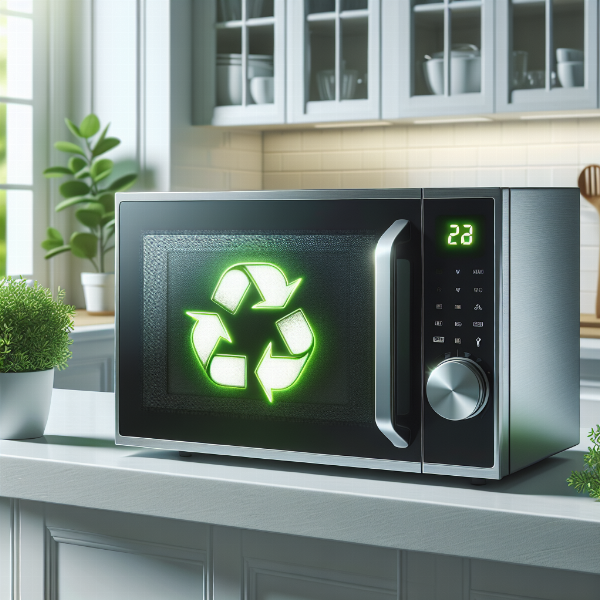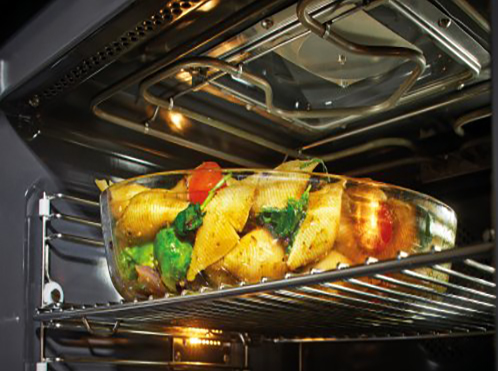In today’s world, making sustainable choices is more important than ever, and our kitchens are a great place to start. While we often think about refrigerators and dishwashers, the humble microwave is a daily workhorse that can have a surprising impact on our energy bills and carbon footprint. That’s where the concept of an Eco Friendly Microwave Oven comes in. But what does that really mean? It’s not just about a green sticker on the box. It’s about smart technology, efficient energy use, and even how we maintain and eventually part ways with our appliance.
Welcome to Microwave Oven Top! As your go-to expert for everything microwave-related, I’m here to demystify the world of green kitchen tech. We’ll explore what makes a microwave truly sustainable, what features to look for, and how you can make your current microwave work smarter, not harder, for both you and the planet. Let’s plug in and get started.
What Exactly Makes a Microwave Oven Eco-Friendly?
The term “eco-friendly” can feel a bit vague. For a microwave, it boils down to three key areas: how much power it consumes while running, how much it uses when idle, and the technology inside that optimizes the cooking process.
Energy Efficiency and Wattage
It’s a common misconception that higher wattage means higher energy consumption overall. While a 1200-watt microwave uses more electricity per second than a 700-watt one, it also cooks food much faster. This can often lead to less total energy use for a given task.
- Cooking Efficiency: A higher-wattage model heats your food more quickly and evenly, reducing overall run time.
- Right-Sizing: The most eco-friendly choice is a microwave that fits your needs. A giant, powerful unit for just reheating coffee is wasteful, while a tiny, underpowered one that takes ages to cook a potato is inefficient. Find the balance.
Standby Power: The Silent Energy Drainer
Ever heard of “vampire power”? It’s the electricity your appliances draw even when they’re turned off. For a microwave, this is the power used to keep the clock and electronic panel lit up 24/7. While it seems small, it adds up significantly over a year. A truly eco friendly microwave oven is designed to minimize this standby power consumption.
Expert Insight from Dr. Elena Vance, Environmental Scientist:
“Consumers often overlook standby power, but it can account for up to 10% of a household’s electricity usage. Look for microwaves with a specific ‘Eco Mode’ or ‘Energy Saving’ feature, which can turn off the display and reduce phantom load to near zero. It’s a small button that makes a big collective difference.”
Advanced Cooking Technology
Modern microwaves are much smarter than their predecessors. The single biggest leap in efficiency is inverter technology.
- Traditional Microwaves: These models cycle their power on and off to simulate lower power levels. The magnetron (the part that creates microwaves) is either blasting at 100% or completely off. This is inefficient and can cook food unevenly.
- Inverter Microwaves: An inverter provides a steady, continuous stream of power at the level you select. If you set it to 50% power, you get 50% power—not a cycle of 100% and 0%. This results in more even cooking, better-tasting food (no more rubbery edges!), and significant energy savings.
 An eco friendly microwave oven displaying its energy saving features and sustainable design
An eco friendly microwave oven displaying its energy saving features and sustainable design
How to Choose an Eco Friendly Microwave Oven
Ready to make a purchase? Keep an eye out for these specific features that signal a greener appliance.
Look for the “Eco Mode” or “Energy Saving” Button
This is the most straightforward feature. A dedicated Eco Mode button typically turns off the digital clock and display when the microwave isn’t in use, cutting standby power consumption drastically. It’s a simple press-of-a-button way to reduce your energy footprint.
Prioritize Inverter Technology
As we discussed, this is a game-changer. Models with inverter technology are almost always more energy-efficient than their traditional counterparts. They might cost a little more upfront, but the energy savings and improved cooking performance are well worth it. Look for terms like “Inverter Technology” or “Sensor Cooking” (which often uses an inverter to precisely adjust power levels).
Consider Size and Material
- Compact Models: If you primarily use your microwave for reheating and defrosting, a smaller, lower-wattage model is a perfectly sustainable choice. There’s no need to power a family-sized unit for a single cup of tea.
- Build Quality: A well-built microwave made from durable materials is more likely to last longer, keeping it out of the landfill. Look for sturdy doors, responsive buttons, and a solid overall feel.
Beyond the Label: How to Use Any Microwave Sustainably
You don’t need a brand-new appliance to be eco-conscious. The way you use and maintain your current microwave has a massive impact on its efficiency. This is where we at Microwave Oven Top really shine—helping you get the most out of what you already own.
Smart Cooking Habits
- Use Microwave-Safe Lids: Covering your food with a microwave-safe lid or plate traps steam, which cooks the food faster and more evenly, reducing cooking time. It also prevents splatters, keeping your microwave cleaner!
- Cut Food into Smaller Pieces: Smaller, uniform pieces cook more quickly and evenly than one large chunk. This simple prep step can shave minutes off your cooking time.
- Use the Right Power Level: Don’t just blast everything on high. Use lower power settings for defrosting or gentle cooking. It uses less energy and gives you a much better result.
- Unplug When Away: If you’re going on vacation, unplug the microwave entirely to eliminate all vampire power draw.
The Power of Maintenance
A clean microwave is an efficient microwave. Food splatters and grime on the interior walls can absorb microwave energy, forcing the appliance to work harder and use more electricity to heat your food.
A Tip from the Trenches with Marco “Sparky” Chen, Appliance Technician:
“I see it all the time. A customer complains their microwave is weak, and I open the door to a mess. The magnetron is working overtime trying to push energy through all that old food. A simple weekly wipe-down with a damp cloth and a bit of vinegar doesn’t just keep it sanitary; it directly impacts its performance and lifespan.”
A clean waveguide cover (the small mica or plastic square on the inside wall) is especially crucial. If it gets clogged with grease, it can cause sparking and permanently damage the magnetron. Check out our [internal link to a detailed cleaning guide] for step-by-step instructions.

A person cleaning the interior of a microwave oven to ensure it remains eco friendly and energy efficient
Repair or Replace? The Green Dilemma
When your microwave breaks down, the instinct is often to just buy a new one. But from a sustainability standpoint, it’s not always the best move. Manufacturing a new appliance has a significant carbon footprint, from sourcing raw materials to shipping the final product.
- Consider a Repair: For common issues like a broken turntable motor, a faulty door switch, or a burned-out lightbulb, a repair is often simple, cheap, and far more environmentally friendly.
- When to Replace: If the magnetron or the main circuit board has failed, the repair cost can sometimes approach the price of a new unit. In this case, or if your microwave is very old and inefficient, replacing it with a modern, energy-saving model might be the greener choice in the long run.
If you do replace it, please dispose of the old one responsibly. Microwaves are e-waste and should not be thrown in the regular trash. Check with your local municipality for e-waste recycling programs.
Conclusion: Your Path to a Greener Kitchen
Choosing and using an eco friendly Microwave Oven is about more than just a label; it’s a holistic approach. It starts with selecting a model with efficient features like inverter technology and an eco mode. But just as importantly, it continues with how you use it every day—through smart cooking habits, regular cleaning, and making a thoughtful decision to repair rather than replace.
By following these tips, you’re not just saving a few dollars on your electricity bill; you’re reducing your environmental impact one reheated meal at a time. Your kitchen is powerful, and with the right knowledge, you can make it a force for good.
Frequently Asked Questions (FAQ)
1. What is the most important feature of an eco-friendly microwave?
While features like Eco Mode are great, inverter technology is arguably the most important. It provides consistent power for more efficient and even cooking, which saves significant energy over the appliance’s lifetime compared to traditional on/off cycling microwaves.
2. Does a lower wattage microwave use less electricity?
Not necessarily. While it draws less power per second, it takes much longer to cook food. A higher-wattage microwave often uses less total energy for a specific cooking task because it completes the job much faster. The key is efficiency, not just raw wattage.
3. How much energy does “Eco Mode” on a microwave actually save?
An Eco Mode that turns off the display can save between 2 and 5 watts of continuous power draw. While that sounds small, over a year it can add up to 40 kWh of electricity, which is a noticeable saving on your bill and for the environment.
4. Can I make my old microwave more eco-friendly?
Absolutely! The best way is through maintenance and smart use. Keep it spotlessly clean inside, cover your food to reduce cooking time, cut food into smaller pieces, and unplug it when not in use for long periods to stop vampire power draw.
5. Is it better for the environment to repair or replace a microwave?
For most common, inexpensive fixes, repairing is always the greener option as it avoids the carbon footprint of manufacturing and shipping a new appliance. However, if the microwave is very old and inefficient, or if a major component like the magnetron fails, replacing it with a new, energy-efficient model can be the better long-term choice.